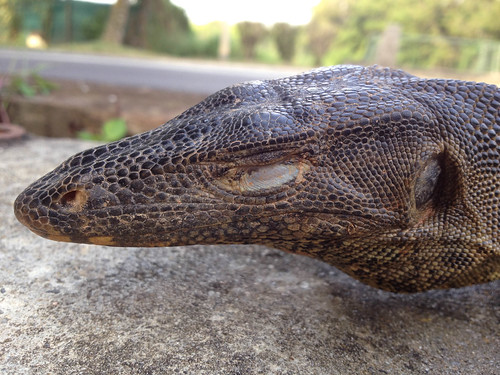
I wasn't quite expecting to be involved in wildlife rescue today. But sometimes, you just happen to stumble upon a wild animal in distress, and you feel that sense of conviction that you have to do something to help.
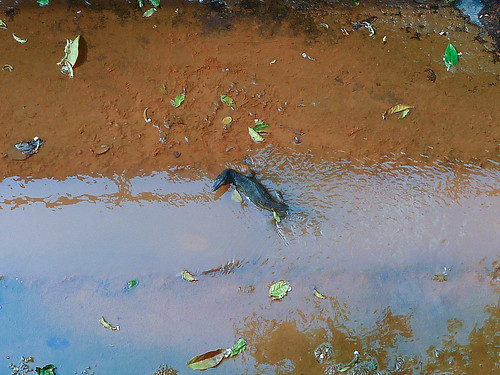
I was walking along a deserted stretch of monsoon canal near Sungei Tengah Road, when I saw a Malayan water monitor (Varanus salvator) inside. Nothing out of the ordinary; these large lizards are typically found close to water, and to them, a concrete drain will do just as well as a natural stream or river. But there was something odd about this particular individual, and I decided to take a closer look.
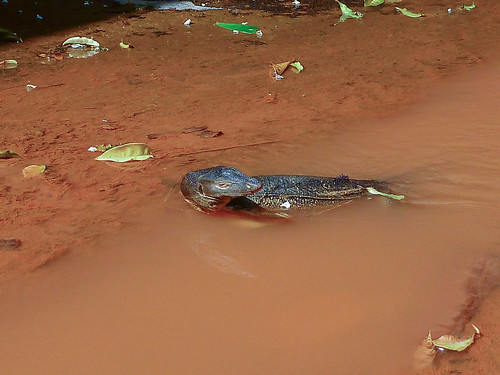
Despite their size, Malayan water monitors are generally shy creatures. Although my general observation is that smaller individuals are more skittish, even the giants of Sungei Buloh will quicken their pace and retreat into the water if you get too close. On many occasions, the only way you'll know of a monitor lizard's presence is the loud rustling or splashing as it makes a sudden dash for cover. Really large ones might puff up their bodies, assume an erect posture, and raise the tail as part of a threat display. However, this lizard was notable in its complete lack of a response to my presence. The least I was expecting was to have it staring at me, and flicking its tongue in and out to detect my scent. Instead, all it did was swivel its head around, almost like it couldn't see me at all and was trying to track the sound of my footsteps.
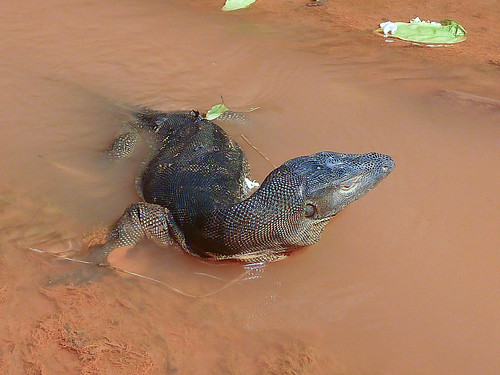

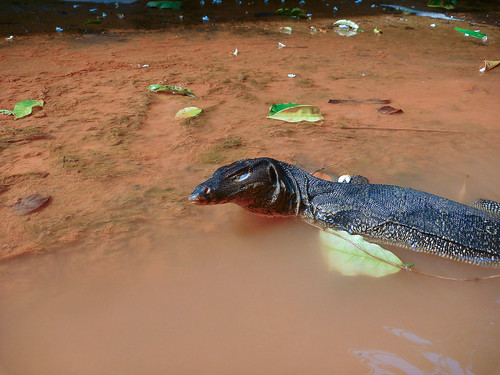
There was something about the eyes that didn't seem right. For some unknown reason, both of the monitor lizard's eyes were tightly shut. Was it blind? Even as I walked right up to it, it didn't even panic at all, and just stayed in place. I waved my hand in front of its face, yes, a silly thing to do as it could have lunged and bitten me, but it didn't even react. I splashed some water at it, but it still didn't budge. I was convinced that yes, there was definitely something wrong with this monitor lizard.
I carried on exploring the length of the canal, and returned a while later. The monitor lizard was still at the same spot, and it certainly didn't look like it was in very good shape.
It wasn't especially emaciated for a monitor lizard of its size, but after you've spent enough time watching monitor lizards going about their daily lives, you soon get a sense of what is 'normal' for a monitor lizard.
Monitor lizards are almost always in control of the situation, and they know it. They have a confident yet inquisitive air about them, as if they know their place as top predators in many of our aquatic ecosystems. They are usually steadfast and sure in their movements. They don't skitter about nervously the way smaller lizards do, but despite their mass, they're not lumbering and awkward. They practically saunter, muscles tensed and primed for explosive action, ready for that moment when the need arrives to lunge at prey, or to escape an even larger foe.
Even while hauled up on the shore basking in the sun, or catching a nap while lounging on a branch, you can tell that a monitor lizard is still very much aware of the goings-on around it. Get too close or make too much noise, and you'll notice one eye languidly open, watching out for any perceived threat. The body tenses for the moment when you cross the invisible boundary, and it bursts from its perch, fleeing for the nearest refuge.
In the water, the monitor lizard swims along with slow but regular and purposeful strokes of the tail, head held above the surface, eyes scanning the surroundings. And whether it's on land or in the water, that characteristic forked tongue is continually flicking in and out, gathering information alien to our us, with our comparatively far weaker primate noses. Monitor lizards are supposedly highly intelligent in comparison to other lizards, and I certainly do not dispute this.
This was not what I saw with the monitor lizard in this drain, so weak that even merely keeping its head above the water seemed to be using up a lot of its strength. There were periods when it rested its head on the ground, as if too tired to keep its head raised. This really was a pale shadow of a healthy monitor lizard.
I had decided that in all likelihood, I would have to call the Wildlife Rescue hotline of the Animal Concerns Research & Education Society (ACRES), and get them to pick up the monitor lizard and see if it was ill. But since this was some distance away from the main road, I thought I ought to transport the lizard to a spot where we could wait for the Wildlife Rescue van.
Now, I'm usually the first person to insist that you do not try to touch a wild monitor lizard. If you don't get whipped hard by the tail, you're bound to end up bleeding badly from serious lacerations caused by its numerous sharp teeth or claws. But seeing how unresponsive this lizard was, I took a gamble. I reached out with one hand and gently touched its back. No response. A more confident, regular stroking. Still nothing. I gently held it around the torso and actually lifted it out of the water. Now, trying to do this with a healthy monitor lizard would trigger a great deal of struggling and violent flailing, with the head, limbs, and tail all thrashing about. But all I got from this lizard was a very feeble stretching and kicking of the limbs.
This was the first time I'd actually handled a monitor lizard, and needless to say I was very excited, while simultaneously concerned about its health and unsure about its apparent lack of aggression towards being manhandled. I was aware that it could suddenly find a surge of energy and scratch, bite, or whip its tail, but it was so docile that I could practically stuff it into my backpack without much difficulty. It was a bit of a tight squeeze to fit inside my bag, but this was the only way I could carry it out of the canal, and fortunately monitor lizards are quite flexible.
Once I had emerged from the canal, I removed it from my backpack. Good, the limbs had tensed a little, and the claws had gotten snagged in the fabric lining the interior of my bag. I spent a few tense moments freeing the claws on each limb from my bag, while hoping that it wouldn't lash out and scratch me. Still, the eyes remained shut, and the tongue still wasn't flicking in and out. The tail, its primary defensive weapon, seemed to hang limply.

I placed it on the ground, where it lay there, limp and motionless, save for the rhythmic expansion and contraction of its thorax as it breathed. I splashed some water to help it cool down in the afternoon heat.
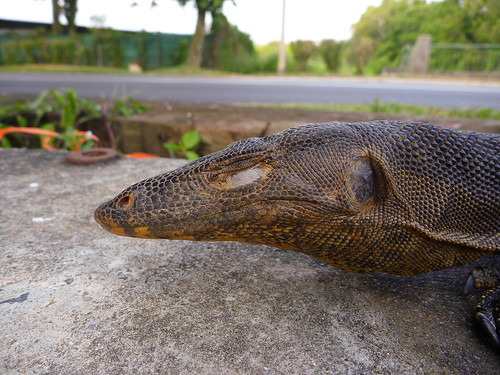
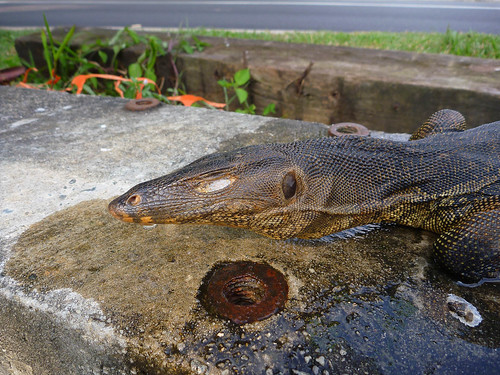
Here's a closer look at the head. I have no idea what's wrong with its eyes. Was there an infection? Was it having problems shedding its skin?
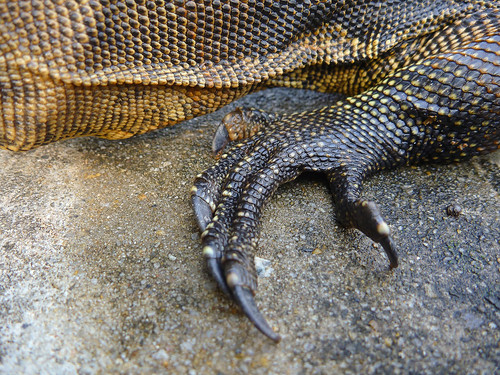
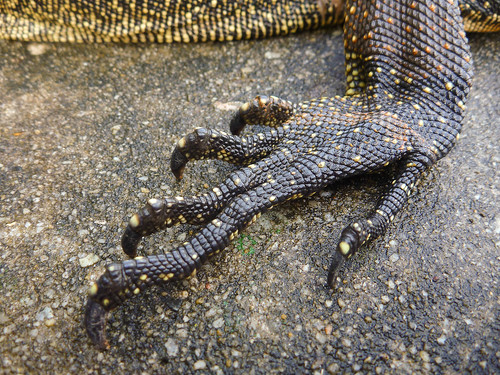
These are the claws that enable a monitor lizard to climb trees and scale vertical concrete or rock surfaces with relative ease. When feeding from large carcasses, the forelimbs provide a secure grip while the head works at ripping off chunks of flesh. Of course, these claws can deal a lot of damage if a monitor lizard struggles.

This shows you how big it was. My rough estimate is that it was approximately 80 centimetres in length; still a juvenile.


Beautiful skin patterns.
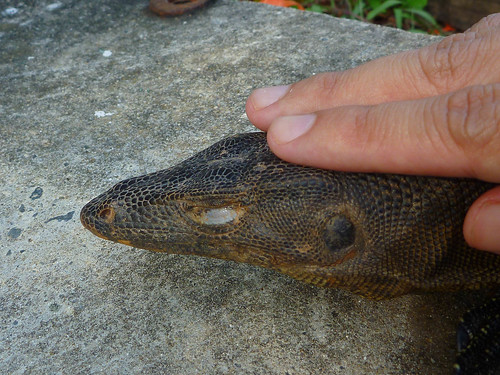
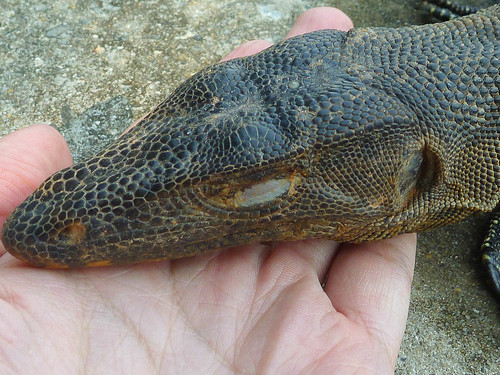
Seriously, I could never possibly think of doing this with a healthy wild Malayan water monitor.
I called the ACRES Wildlife Rescue hotline, gave them a brief description about the situation, and stated my location. Because they were occupied with attending to other calls and were busy, I was told that I might have to wait as long as an hour before they could drive over and attend to this case. I decided to ask if it might be better if I personally delivered it to the Wildlife Rescue Centre, seeing that it was just a short distance away, and I had a bag to transport it in.
And so, I set off for the Wildlife Rescue Centre, about 10 minutes' walking distance from my location. I tried my best not to jostle the lizard around too much while it was in my backpack; being captured was probably stressful enough for the sickly lizard, I didn't want to cause it further trauma. I'd already alerted ACRES with a tweet, and so when I arrived, the whole procedure was done very smoothly. I handed it over to the veterinarians and shared with them how weak and listless it was. To further prove my point, I emphasised that I'd just handled a wild monitor lizard with just my bare hands, and didn't get bitten or scratched at all. There was certainly something quite wrong with this lizard's health.
In my excitement, I forgot to take more photos of the monitor lizard while it was in the treatment room.
This is the second animal in distress that I've retrieved and handed over to ACRES Wildlife Rescue; the first was a red-eared slider (Trachemys scripta elegans) that I'd found in a drain outside Lorong Halus Wetlands with a fishing hook lodged in its mouth.
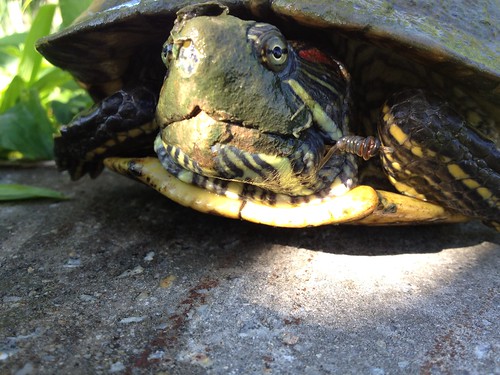
This also happened to be the second Malayan water monitor that I'd helped to save; in December 2007, I alerted everyone else to a monitor lizard entangled in a driftnet on Pulau Sekudu and wedged amongst the boulders. If we hadn't found it that day, it most likely would have drowned as the tide rose. The others in my group took charge of the task of cutting it free of the net, as they were armed with the right tools. Now that was one feisty lizard, from the way it struggled and writhed, and even latched onto Terry's finger; luckily he was wearing thick rubber gloves!
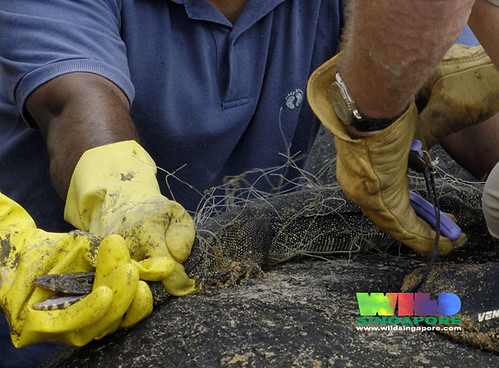
(Photo by Ria)
I can safely say that this really is my closest ever contact with a Malayan water monitor, and while I am still very excited about the whole experience, and really stoked about playing a part in rescuing it, I know that I would probably have been just as glad if I had crossed paths with a perfectly healthy monitor lizard. I hope ACRES is able to figure out what's wrong with it, and that it'll be able to make a full recovery.
A reminder: Handling this monitor lizard involved a great deal of risk-taking, craziness, and recklessness on my part, and perhaps it was more due to luck and this lizard's poor health that I wasn't bitten or scratched. It's also likely that I would have been more hesitant to do what I did if the lizard was any larger. Do not attempt to catch or handle healthy monitor lizards, especially if you're unfamiliar with wildlife. It's best that you appreciate these majestic and powerful reptiles from a distance, and leave the lizard wrangling to professionals like ACRES Wildlife Rescue.
Update (23rd August): I was just informed by ACRES that unfortunately, the monitor lizard wasn't responding to treatment, appeared to have a crippled right forelimb, and seemed to have a permanently twisted neck. As a result, it was euthanised. Oh well.